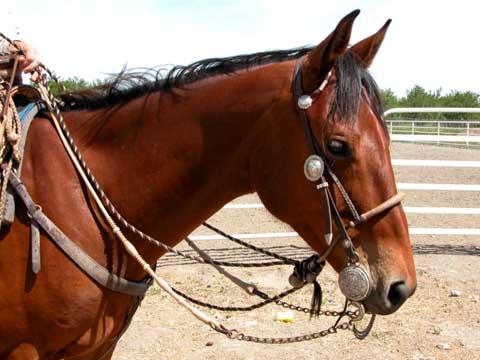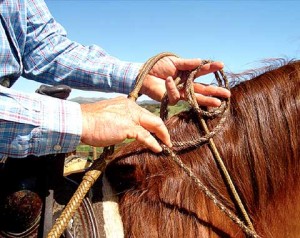
There are many ways to start and train a horse but the way traditional Californio vaqueros did it remains a popular, and my favorite, approach.
First you use only a snaffle bit and then only a hackamore, followed by a two-rein phase of bridle horse training, and finishing with a “straight up” bit. This will take several years but there is nothing finer than a finished bridled horse. Richard Caldwell doesn’t even introduce his horses to two-rein until they are 5-6 years old. He likes training to be slow and easy.
During the two rein phase, the horse has a pencil thin (typically 3/8″) bosal, called a bosalita, and a mecate that is approximately the same fine thin width. The bosalita fits the way way the previous hackamore did but because of the much smaller diameter it can fit under the bridle. It should be in exactly the same position as the hackamore was because the idea of this transition phase is to remind the horse what you want using the bosalita – while at the same time introducing him to new cues from the spade bit.
A bridle with a spade bit or a half-breed mouthpiece is attached to finely braided reins with a romal that is fitted over the bosalita. The rider uses all four reins to direct the horse.
Les Vogt recommends using a 8-10 link chain from the bit to the rein to give a “pre-signal” and to keep the curb strap loose. “I want the horse to operate off the bit, and not the curb strap.”
 There are many ways to hold the reins but what is common is the bosal reins are on top. Again quoting Les “I carry the reins in my left hand. I split the rawhide reins with four fingers and carry a coal of the little hair rope with the same four fingers. I also keep the left bosal rein slightly shorter than the rest.”
There are many ways to hold the reins but what is common is the bosal reins are on top. Again quoting Les “I carry the reins in my left hand. I split the rawhide reins with four fingers and carry a coal of the little hair rope with the same four fingers. I also keep the left bosal rein slightly shorter than the rest.”
The golden rule in the beginning is to not put pressure on the bit itself. That feels strange to the horse and we don’t want him fighting it. So start teaching neck reining by putting the reins against the horses neck and then use the bosalita to tell him what you want (move his head). After a while he’ll realize that he needs to turn when he feels the reins. Slowly, the horse learns to pick up and carry the bit in his mouth. When that is accepted the rider gradually begins to use the bridle reins more with a little support from the mecate.
Richard Caldwell says “Your mecate and bridle reins should be adjusted to the point your horse can feel finger pressure and you don’t have to move your hands and arms too far to the side. If you have to move outside the three inch box [in front of the saddle horn] with your mecate, you’re pulling your horse more than necessary to get a signal. Remember, a horse learns from the release, not the pull.”
Richard also has some great advice. “The vaqueros developed this system so that there’s something you can go back to if problems arise at the next stage. It there’s a problem, it’s better to go back and fix it.”
If you have problems seeing the video below click HERE
.youtube::XQBRiilHMhs::

I had a horse in the two-rein last year. I now use a spoon spade bit with him. I really enjoyed the two rein phase, the transition between using all bosal reins to the bridle reins is fun to experience.